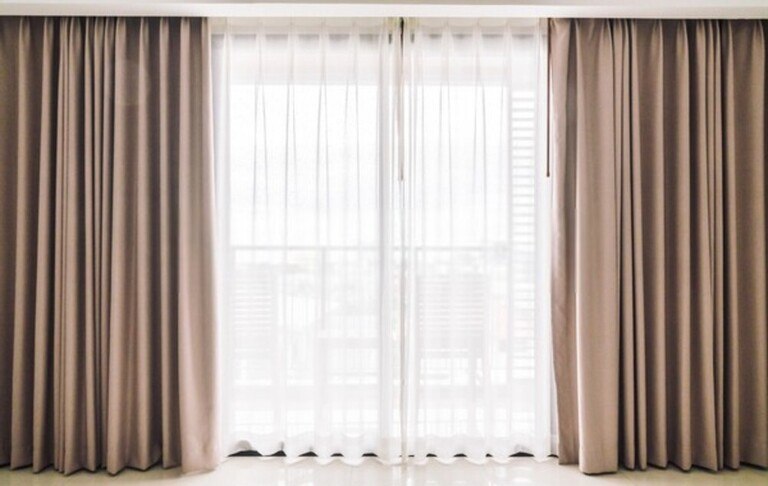You’ll probably want to soundproof a room if it is going to be used as your home office, reading/study room, baby room, or bedroom. In some cases, having noisy neighbors is another reason.
Below are our tips on how to soundproof a room from outdoor noise, from the most inexpensive to the easiest. Keep reading!
Install Soundproof Curtain Or Thick Curtain

One of the easiest ways to partially suppress the outside noise is to install thick curtains. They are also a good supplement for optimal soundproofing effects for those houses that are already constructed with thick soundproof walls.
If your budget is on the table, go for soundproof models since they’ll reduce the noise much better.
Use A Bookshelf

This solution is perfect to be used in apartment blocks and with noisy neighbors.
A bookshelf not only thickens your house walls for soundproof enhancement but is also a perfect ornament, especially for bookworms.
Install Soundproof Door Strip
The gap between your door and the floor is just like a “gate” to welcome loud noise from the outside.
The bigger the gap, the less soundproofing the room.

From that point, consider using a soundproof door strip for not only your main door but also your windows. With a too large gap, you can attach a piece of wood at the bottom of the door, then use the soundproof strip.
Soundproof Stickers
If you don’t like to rebuild your house walls but still want to increase their soundproofing, this is a great alternative – soundproof stickers.

Fiberglass and mineral wool are the most common materials of these products. Besides, they’re varied in terms of colors, sizes, and shapes, resulting in vast price ranges.
Soundproof stickers absorb low to high frequency sounds excellent. Some products are manufactured with a layer of glue on the back for sticking to the wall while others require using 3M spraying glue.
Depending on the outside noise level and your preference, you can cover the four walls of your room or just one of them.
Aside from reducing the outside noise, these products help music played, radios or your singing voice sound a lot better.
Seal Cracks And Crevices Around The Room With Soundproof Sealant
Don’t you know that even a small gap or crevice can ruin the soundproofing capabilities of your room?
To solve that, soundproof sealants are a great choice.

Look around the room, especially in walls and windows, for any crack, gap, or crevice. If it is very tiny, consider using conventional sealants because the soundproof one is harder to apply.
If the sealant product doesn’t match the wall color, choose a paintable one. water-based sealants are easier to remove than solvent-based. If you intend to go for the second type, make sure to choose from a reliable brand and it must not damage your room materials.
Thick Sound Insulation Materials
If you want to renovate the existing walls of your room, then build the basic wall structure and attach it to its surface with dense sound insulation material. Use studs to keep them in place better.
Lastly, cover them with new plasterboard.

As a basic rule of thumb, the thicker the material, the better the sound-absorbing capability. The ideal thickness of sound insulation material should be at least 0.6”.
Separate The Two Layers Of Your House Wall
When the sound goes through a layer of wall material, part of the energy is absorbed and the rest is reflected.
From that point, try increasing this effect by building walls from two separate layers of drywall or plaster. The greater the distance between them, the better.
Actually, the soundproofing capability of a double-layer wall isn’t decent on low-frequency noise, because the sound is reflected.
If the gap between these layers is only 1” or thinner, it is recommended to use sound-absorbing materials to counteract this drawback.
Soundproofing Clips And Resilient Channels
These items are placed between the rivet and the drywall to increase your wall’s soundproofing.
Soundproofing clips are the most effective since they absorb noise with heavy-duty rubber parts. To use these clips, fasten them to your wall with studs, insert the chute in, then snap the drywall into the chute.

Resilient channels are made of metal with resilient properties for sound damping capabilities. Attach them to the wall with a rivet, then attach drywall to them using a corner screw.
Note that resilient channels work well on high-frequency noises only.
Other Soundproofing Materials
While dedicated sound-damping materials are best in muting loud noise from the outside, there are many wonderful alternatives, such as:
Fiberglass compound is inexpensive yet very effective – perfect for people who are on a tight budget.
Soundproof foam – try it if the outside noise around your room isn’t at high frequency.

Soundproof The Floor And Ceiling
Only use this way if there’s a room below or above yours.
An easy solution to soundproof the floor is by covering it with a sound-damping mattress, then top up with a thick carpet.
With the ceiling, install plasterboard and leave a gap between it and the ceiling, or you can fill it with a fiberglass compound.
Conclusion
To make this post more informative, here are some extra notes for you:
- The STC standards don’t always work since they don’t take into account sound frequencies under 125Hz, such as construction, aircraft, vehicles, and music noise.
- Major constructing or repairing projects to walls, floors, and ceilings should be done under the supervision of experienced personnel.
Hope that through our guide, you now get more solutions on how to soundproof a room from outside noise. Thanks for reading!













